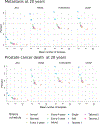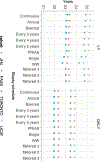Prostate cancer mortality and metastasis under different biopsy frequencies in North American active surveillance cohorts
- PMID: 31639200
- PMCID: PMC6980275
- DOI: 10.1002/cncr.32557
Prostate cancer mortality and metastasis under different biopsy frequencies in North American active surveillance cohorts
Abstract
Background: Active surveillance (AS) is an accepted means of managing low-risk prostate cancer. Because of the rarity of downstream events, data from existing AS cohorts cannot yet address how differences in surveillance intensity affect metastasis and mortality. This study projected the comparative benefits of different AS schedules in men diagnosed with prostate cancer who had Gleason score (GS) ≤6 disease and risk profiles similar to those in North American AS cohorts.
Methods: Times of GS upgrading were simulated based on AS data from the University of Toronto, Johns Hopkins University, the University of California at San Francisco, and the Canary Pass Active Surveillance Cohort. Times to metastasis and prostate cancer death, informed by models from the Scandinavian Prostate Cancer Group 4 trial, were projected under biopsy surveillance schedules ranging from watchful waiting to annual biopsies. Outcomes included the risk of metastasis, the risk of death, remaining life-years (LYs), and quality-adjusted LYs.
Results: Compared with watchful waiting, AS biopsies reduced the risk of prostate cancer metastasis and prostate cancer death at 20 years by 1.4% to 3.3% and 1.0% to 2.4%, respectively; and 5-year biopsies reduced the risk of metastasis and prostate cancer death by 1.0% to 2.4% and 0.6% to 1.6%, respectively. There was little difference between annual and 5-year biopsy schedules in terms of LYs (range of differences, 0.04-0.16 LYs) and quality-adjusted LYs (range of differences, -0.02 to 0.09 quality-adjusted LYs).
Conclusions: Among men diagnosed with GS ≤6 prostate cancer, obtaining a biopsy every 3 or 4 years appears to be an acceptable alternative to more frequent biopsies. Reducing surveillance intensity for those who have a low risk of progression reduces the number of biopsies while preserving the benefit of more frequent schedules.
Keywords: Gleason score; active surveillance; biopsy; microsimulation; prostate cancer.
© 2019 American Cancer Society.
Conflict of interest statement
Conflicts of Interest:
BJT reports grants from MDxHealth, personal fees from GenomeDx Biosciences, and grants and personal fees from Myriad Genetics outside the submitted work. MRC reports personal fees from Dendreon, Astellas, GenomeDx, Myriad Genetics, and MDxHealth outside the submitted work. JEC reports that she is a paid statistical peer reviewer for Journal of Urology and Urology. SVC has received a lecture honorarium and travel support from Astellas Pharma (unrelated to current study). Authors not named here have disclosed no conflicts of interest.
Figures





Comment in
-
Re: Prostate Cancer Mortality and Metastasis under Different Biopsy Frequencies in North American Active Surveillance Cohorts.J Urol. 2020 Aug;204(2):387. doi: 10.1097/JU.0000000000001115.01. Epub 2020 May 13. J Urol. 2020. PMID: 32401651 No abstract available.
References
-
- Chen RC et al. Active surveillance for the management of localized prostate cancer (Cancer Care Ontario guideline): American society of clinical oncology clinical practice guideline endorsement. J. Clin. Oncol. 34, 2182–2190 (2016). - PubMed
-
- Briganti A. et al. Active Surveillance for Low-risk Prostate Cancer: The European Association of Urology Position in 2018. Eur. Urol. 74, 357–368 (2018). - PubMed
-
- Sanda M. et al. Clinically Localized Prostate Cancer: AUA/ASTRO/SUO Guideline. Part I: Risk Stratification, Shared Decision Making, and Care Options. J. Urol. 199, 683–690 (2018). - PubMed
Publication types
MeSH terms
Substances
Grants and funding
LinkOut - more resources
Full Text Sources
Medical
Research Materials

